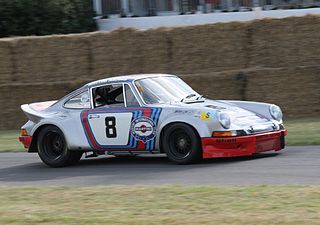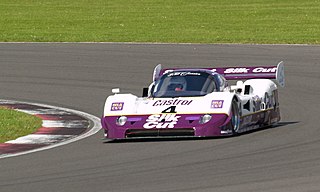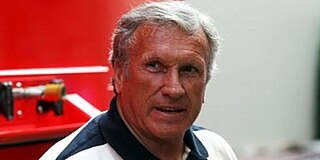
Jaguar Racing is the name given to Jaguar's racing interests. It currently competes in Formula E under the name Panasonic Jaguar Racing. It was previously a Formula One constructor that competed in the FIA Formula One World Championship from 2000 to 2004.

Derek Reginald Bell is a British racing driver. In sportscar racing, he won the Le Mans 24 hours five times, the Daytona 24 three times and the World Sportscar Championship twice. He also raced in Formula One for the Ferrari, Wheatcroft, McLaren, Surtees and Tecno teams. He has been described by fellow racer Hans-Joachim Stuck as one of the most liked drivers of his generation.

The Porsche 962 is a sports-prototype racing car built by Porsche as a replacement for the 956 and designed mainly to comply with IMSA's GTP regulations, although it would later compete in the European Group C formula as the 956 had. The 962 was introduced at the end of 1984, from which it quickly became successful through private owners while having a remarkably long-lived career, with some examples still proving competitive into the mid-1990s. The vehicle was later replaced by the Porsche WSC-95.
Tom Walkinshaw Racing (TWR) was a motor racing team and engineering firm founded in 1976, in Kidlington, near Oxford, England by touring car racer Tom Walkinshaw.

The Jaguar XJR-9 is a sports-prototype race car built by Jaguar for both FIA Group C and IMSA Camel GTP racing, debuting at the 1988 24 Hours of Daytona.
The 1991 24 Hours of Le Mans was the 59th Grand Prix of Endurance, and took place on 22 and 23 June 1991. It was also the fourth round of the 1991 FIA Sportscar World Championship season.
Joest Racing is a sports car racing team that was established in 1978 by former Porsche works racer Reinhold Joest. The headquarters are in Wald-Michelbach, Germany. The team currently competes in the IMSA WeatherTech SportsCar Championship as Mazda Team Joest under a works contract with Mazda.

The Jaguar XJR-14 is a sports-prototype racing car introduced for the 1991 World Sportscar Championship season. It was designed by Ross Brawn and John Piper, and was built and run by Tom Walkinshaw Racing (TWR), on behalf of Jaguar Cars.

The 1992 Sportscar World Championship season was the 40th and final season of FIA World Sportscar Championship motor racing. It featured the 1992 FIA Sportscar World Championship, which was contested over a six race series which ran from 26 April to 18 October 1992. The championship was open to Group C Sportscars.

The Mazda MXR-01 is a Group C sports prototype that was used by Mazda's factory team Mazdaspeed in the 1992 World Sportscar Championship season. It would be the final Mazda entry in sports car racing since the inception of its Le Mans project in 1983.

The Jaguar XJR sportscars were a series of race cars used by Jaguar-backed teams in both the World Sportscar Championship (WSC) Group C and the IMSA Camel GTP series between 1984 and 1993.

The Aston Martin DBR1 was a sports racing car built by Aston Martin starting in 1956, intended for the World Sportscar Championship as well as non-championship sportscar races at the time. It is most famous as the victor of the 1959 24 Hours of Le Mans, Aston Martin's only outright victory at the endurance classic. It is one of only three cars in the 1950s to win both the World Sports Car Championship and Le Mans 24 Hours in the same year. In addition the six World Sports Car Championship victories was a record for any car in the 1950s and remained a record in the championship until surpassed by the Ferrari 250TR. The three consecutive triumphs in 1959 at the Nürburgring, Le Mans and the Tourist Trophy equalled the record set by the Ferrari 250TR with its three consecutive victories at the start of the 1958 season.

Porsche has been successful in many branches of motorsport of which most have been in long distance races.

The Porsche WSC-95 was a Le Mans Prototype originally built by Tom Walkinshaw Racing. It was modified by Porsche from the original Group C Jaguar XJR-14 from which it derived, and run by Joest Racing. Originally intended to race in the IMSA World Sportscar Championship, the WSC-95 saw very little race action even though it won the 24 Hours of Le Mans in both 1996 and 1997 without being acknowledged as a factory supported project. It was later upgraded to the Porsche LMP1-98 before being retired. Only two cars were ever built.

The Jaguar XJR-11 was a sports-prototype racing car introduced for the 1989 World Sports Prototype Championship, while its sister car the XJR-10 was introduced to compete in IMSA series races.

The Jaguar XJR-12 is a sports-prototype race car built by the Jaguar Cars-backed Tom Walkinshaw Racing team for both Group C and IMSA Camel GTP. The XJR-12 is famous for winning the 1990 24 Hours of Le Mans race.
The Jaguar XJR-17 was an IMSA Lights racing car, built by Tom Walkinshaw Racing. Rebuilt from a Jaguar XJR-16 for the IMSA Camel Lights, the XJR-17 never competed in the event due to funding issues and has since only been used in a few minor British events and historic races. It used a modified version of the XJR-16's 3.5-litre V6 engine, stripped of the twin-turbochargers and producing a claimed output of 450 hp, whilst its bodywork was cobbled together using various parts from older Jaguar XJR Sportscars.
Michael Thomas Salmon was a British racing driver from England who competed in the 24 Hours of Le Mans between 1962 and 1984. He was also active in the British Saloon Car Championship and the World and European Endurance championships.
Manfred Schurti is a former touring and prototype racing car driver from Liechtenstein mainly known for racing factory-entered Porsches.






















